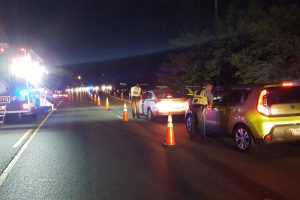
There are significant spikes in impaired driving crashes on holidays and weekends. That’s why law enforcement officers often set up sobriety checkpoints at these times. In some areas, law enforcement agencies increase patrols (known as saturation patrols) to watch for impaired driving behaviors. In others, they set up roadblock-style checkpoints where all drivers are stopped and engaged in a short conversation while an officer assesses their sobriety. Understanding what to expect at a sobriety checkpoint can help drivers move through the process more quickly so everyone can get home safely for the night.
After You Pull Over
What happens after a driver is pulled over might differ depending on whether they’re at a roadblock- style checkpoint or pulled over by an officer patrolling the area. Officers make decisions about how to proceed once they speak with a driver, ask questions, and observe their actions. If officers don’t smell alcohol or detect signs of impairment, they might allow a driver to go on their way. If an officer suspects someone is driving under the influence, they may ask them to exit the vehicle for a field sobriety test. The Standardized Field Sobriety Test involves three separate tests:
- Horizontal gaze nystagmus (HGN) test. This term refers to the involuntary jerking of the eye that occurs when gazing to the side. This effect is exaggerated in a driver who is impaired by alcohol. An officer might use a pen, flashlight, or another small object to track a driver’s eye movements.
- Walk and turn test. An officer will ask the driver to walk in a straight line, taking nine steps – heel-to-toe – then turn and come back in the same manner. This checks a driver’s overall balance, coordination, and ability to follow instructions.
- One-leg stand test. A driver will be asked to stand on one foot and hold the position for 30 seconds, counting aloud. An officer will observe whether the driver sways, hops or loses count when attempting to stay balanced.
It should be noted that officers are well-trained to perform these tests in a variety of circumstances and situations. If medical, physical, or other limiting factors exist, the investigating officer will take these under consideration during the administration of the field sobriety test.
Taking the Portable Breath Test (PBT)
In some cases, an officer might ask a driver to submit to a portable breath test (PBT). The breath test will estimate a driver’s blood alcohol concentration (BAC) to determine whether they’re over the legal limit of 0.08%. While the PBT is used as a guide, even if someone tests under the limit, they could still receive a citation if they’re impaired. Maryland has a zero-tolerance limit for drivers under the age 21, so any alcohol detection will result in a failed test.
Are Sobriety Checkpoints Legal?
The Supreme Court determined checkpoints are legal if they follow certain guidelines. Some of these include:
- Checkpoints must be clearly labeled so drivers know about the stop in advance. Approaching drivers must be given adequate warning a checkpoint is ahead.
- Locations must be logical and significant (areas where there have been previous instances of impaired driving, for example). Supporting data, such as citizen complaints, crash data, DUI arrest data, etc., are considered when choosing a checkpoint location.
- Driver selection must be neutral and impartial. In Maryland, all vehicles are stopped at sobriety checkpoints.
- An initial assessment of each driver should be done as quickly and safely as possible. If an officer feels there’s a need to conduct further investigation, a driver should be directed to a pre-determined area for a more thorough assessment.
- Probable cause is necessary for giving field sobriety and breathalyzer tests.
Can I Refuse a Breath/Blood Test?
If you’re a Maryland driver and refuse a test to determine your blood alcohol or drug concentration, you will be issued an Order of Suspension (form #DR-015A) along with your traffic citation(s). A police officer will confiscate your driver’s license and may issue a temporary paper license. If you’re a commercial driver’s license holder, MDOT MVA will suspend the license and could disqualify your driving privilege.
The suspension/disqualification periods are as follows:
Submitted to the test and failed: Blood Alcohol Content 0.08 through 0.14
- 1st offense – 180-day suspension;
- 1st offense involving fatality – 180-day suspension;
- 2nd or subsequent – 180-day suspension; and
- 2nd or subsequent involving fatality – 1-year suspension.
Submitted to the test and failed: Blood Alcohol Content 0.15 or more
- 1st offense – 180-day suspension;
- 1st offense involving a fatality – 1-year suspension;
- 2nd or subsequent offense – 180-day suspension; and
- 2nd or subsequent involving fatality – revocation.
Refused to submit to the test:
- 1st offense – 270-day suspension; and
- 2nd or subsequent offense – 2-year suspension.
Operating a commercial motor vehicle at the time:
- 1st offense – 1-year Commercial Driver’s License (CDL) disqualification; and
- 2nd or subsequent offense – lifetime CDL disqualification.
Operating a commercial motor vehicle carrying hazardous materials at the time:
- 1st offense – 3-year CDL disqualification; and
- 2nd or subsequent offense – lifetime CDL disqualification.
Why Stop If I’m Sober?
Not stopping at a checkpoint is unsafe and could result in a driver being stopped by support units. Please be mindful of the safety of officers and other drivers and stop when instructed. Once you are cleared by officers, take the opportunity to thank them for their service. Sobriety checkpoints and the officers who facilitate them help keep drunk drivers off the road and increase the safety of our roadways.